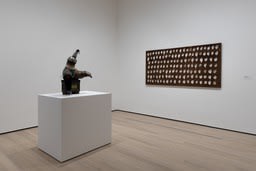[...]
If you’ve read anything about the reinstallation of MoMA’s collection, you will know the basics: film, photography, design, and architecture holdings have been integrated into the heart of the story, so that building maquettes, Modernist floor plans, stills from classic films, troves of vernacular photos, and looping film clips alternate with the conventional displays of painting and sculpture. An attempt has been made to add more women artists, minorities, and non-Western voices throughout, as well as to break down, to a certain extent, the membrane between “insider” and “outsider” art.
It’s all broadly chronological, still, with art from the 1880s to to 1940s up on the fifth floor, the 1940s to the 1970s on the fourth, and the post-1970s contemporary down on the second. But it no longer marches to the rhythm of the art historical movements familiar from old college art surveys. Instead there are more thematic rooms. Sometimes the themes are pegs to hang a familiar MoMA-approved cluster of artists on, e.g. “Readymade in Paris and New York,” “Surrealist Objects,” “Planes of Color.” Sometimes these are more allusive and deliberately mushy, allowing for conjugations of works you might not think about together: e.g. “Responding to War,” “Stamp, Scavenge, Crush,” “Inner and Outer Space.” As art history, it feels lumpy: different thoughts and strategies are happening from gallery to gallery.
[...]
Introducing the volume Modern Art in Africa, Asia, and Latin America, art historian Eileen O’Brien writes of the need to reject an approach to global modernism whereby “artworks are presented thematically, as if they had no histories or precursors.” This pretty much exactly describes what you get when, say, you pay homage to Korea’s recently hotly discussed Dansaekhwa (“Monochrome”) movement of abstract painting via exactly one 1974 dotted burlap canvas by Ha Chong-Hyun, placed in a gallery dedicated to responses to violence and oppression (“War Within, War Without”). Enwezor mentions a “heterotemporal” and “heterochronological” approach—which really just means: Give the “new” art histories the dignity of their own spaces and contexts. Do an actual gallery of Japan’s Gutai movement (rather than a single drawing by Atsuko Tanaka mixed in with a bunch of other stuff), or the Bombay Progressives (rather than just that lonely Gaitonde), or Dansaekhwa. MoMA’s thematic approach starts to read like an expedient way not to concede this space.
[...]
—Ben Davis

